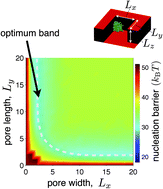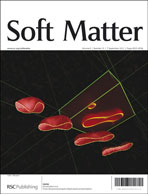Patterning a surface so as to speed nucleation from solution
Abstract
Motivated by the question of how to pattern a surface in order to best speed nucleation from solution, we build on the work of Page and Sear [Phys. Rev. Lett., 2006, 97, 65701] and calculate rates and free energy profiles for nucleation in the 3d Ising model in the presence of cuboidal pores. Pores of well-chosen aspect ratio can dramatically speed nucleation relative to a planar surface made of the same material, while badly chosen pores provide no such enhancement. For a given pore, the maximum nucleation rate is achieved when one of its two horizontal dimensions attains a critical length, largely irrespective of the other dimension (provided that the latter is large enough). This observation implies that


 Please wait while we load your content...
Please wait while we load your content...